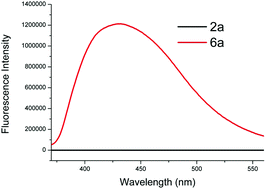One-pot synthesis of boron diketonate complexes: photophysical properties and sensor for picric acid†
Abstract
Boron diketonate complexes were synthesized via a one-pot method. The method focused on the selective synthesis of unsymmetric boron diketonate by involving BF3–OEt2 and β-ketothiolester intermediates generated in situ from α-aroylketene dithioacetals using p-toluenesulfonic acid as a catalyst. The unsymmetrical boron diketonate complexes are emissive both in solution and in the solid state with high quantum yield and large Stokes shift. The boron diketonate 6e selectively senses picric acid over other nitroaromatic compounds with a detection limit of 21.5 μM.


 Please wait while we load your content...
Please wait while we load your content...